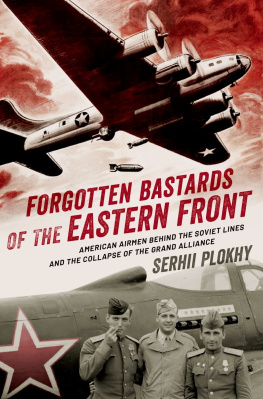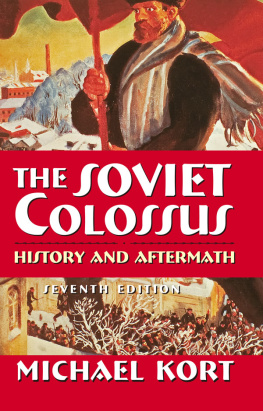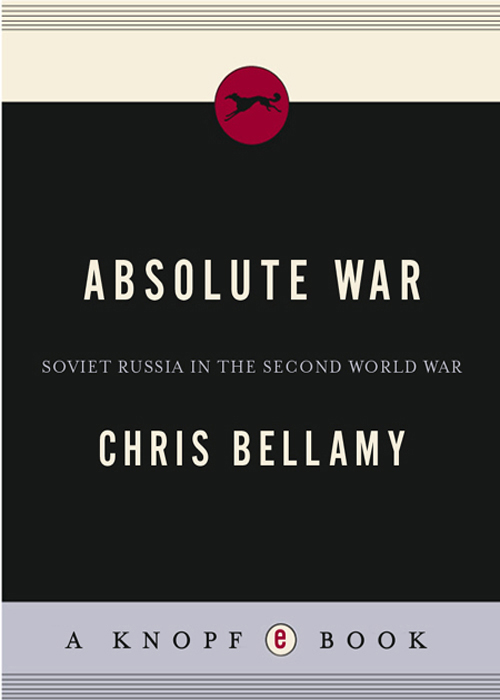Illustrations, figures and tables
Illustrations
The partition of Poland: the map signed by Stalin and von Ribbentrop, 28 September 1939. (Rodina)
Agent report from Starshina, Berlin, 17 June 1941, and Stalins comment. (Rodina)
German intelligence map of their own and Soviet dispositions, 21 June 1941. (BA-MA Koblenz)
Stalin: Time magazines unlikely Man of the Year, 1942. (Time)
Order to evacuate Moscow, October 1941, with Stalins amendments. (Rodina)
Central Committee to Zhdanov 13 June 1948. Document confirming that the twenty-eight Panfilov heroes story is false. (Rodina)
Elena Vasilevna, a child during the war, tells of the siege of Leningrad. Museum of the Road of Life, March 2005. (Author)
Lavrenty Pavlovich Beria, Peoples Commissar for Internal Affairs, head of the NKVD and NKGB and member of the State Defence Council. (GKO)
Aleksandra Kollontai, writer and Soviet ambassador to Sweden.
Timoshenko (left) and Zhukov (right) on pre-war manoeuvres. (Rodina)
Russian soldier taken prisoner in the frontier battles, 1941. (BA-MA Koblenz)
Bewildered Soviet soldiers surrender 1941. (BA-MA Koblenz)
The moral and physical components, shattered. Defeat and victory, 1941. (BA-MA Koblenz)
Russian prisoners taken in the renewed German drive, operation Blau, 1942. This photograph could equally have been taken in 1941. (BA-MA Koblenz)
Russian prisoners, the Crimea, 1942. The picture is uncannily reminiscent of some taken in Iraq in 1991. (BA-MA Koblenz)
Russian ski troops, 1941. (Rodina)
Winter offensive, Moscow, 1941. (Rodina)
Dovators cavalry in the Moscow counter-offensive, 1941. (Rodina)
Armies march on their stomachs. A field kitchen in winter. (Rodina)
Destroy the German monster: Leningrad poster, 19412. (Rodina)
Leningrad fire-fighter. (Rodina)
Victims of an air-raid on Leningrad. (Rodina)
Suspected collaborators in the hands of the NKVD. (Rodina)
Woman sniper. (Rodina)
Po-2 night bomber of the 46th Guards night witches regiment. (Rodina)
Women pilots, Novorossiysk, 1943. (Rodina)
Heroines of the Soviet Union N. V. Kovshova and M. S. Polivanova. (Author)
Women snipers, 1945. (Rodina)
Khrushchev and Brezhnev, 1942. (Rodina)
Russian map of northern Stalingrad. (Authors collection)
Lt Gen. Vasiliy Chuikov, commanding Sixty Second Army, drawn by Finogenov.
Chuikovs command bunker, dug into the Volga bank, drawn by Finogenov.
Chuikov and his staff holding central Stalingrad. (Rodina)
Still a secret weapon: a Katyusha multiple rocket launcher fires in the distance, drawn by Finogenov.
Rokossovskiy, during the Moscow winter offensive the year before. (Rodina)
Surrender at Stalingrad, drawn by Finogenov.
Pauluss interrogation, drawn by Finogenov.
Paulus (left) and his Chief of Staff, Lt Gen. Schmidt (right) under interrogation after Stalingrad. (Rodina)
Zhukov and Koniev. (Rodina)
Ilyushin-2 Shturmovik ground attack planes over Berlin. (Rodina)
German prisoners being marched through the streets of Moscow. (Rodina)
Rokossovskiy in the new, post-15 January 1943, uniform. (Rodina)
The cruiser Paris Commune firing in defence of Sevastopol, 1941.(Rodina)
Churchill and Molotov, during Molotovs visit to Britain, May 1942.(Rodina)
The big three: Churchill, Roosevelt, and Stalin at Yalta, February 1945. (IWM)
Revenge of the bear: after the destruction of the Army Group Centre, illustrated by the broken rifle, vengeful Russia advances on Hitlers Germany. (Illingworth cartoon, Solo Syndication)
Red flag over the Reichstag. Re-enactment of 2 May. (Rodina)
Yevgeniy Khaldei, war photographer, in Berlin. The tank behind him is the new JS-II. (Rodina)
Victory in Berlin. Maria Shalneva, Soviet traffic policewoman, in Berlin. (Rodina)
German prisoners of the Russians at the end of the war. (Rodina)
The writer Konstantin Simonov with the Soviet forces as a war correspondent. (Rodina)
Unconditional surrender: Keitel signs for Germany at one of the ceremonies. The official capitulation was signed by Jodl, the designated representative of the German state what was left of it. (IWM)
The United Nations the four powers that will occupy Germany witness the surrender. Zhukov represents the Soviet Union. (IWM)
Stalin and his generals. (Rodina)
Zhukov, Rokossovskiy, Sokolovskiy and Vasilevskiy in Berlin after the award of British honours. (IWM)
The end of Nazi Germany and Austria. (Authors collection)
Figures
Legacy of the war. Russian population by age, 1990.
Legacy of the war. Russian population by age, 2005.
Europe at the end of November 1940.
Soviet expansion in Europe, 193940, showing boundary changes.
The Russo-Finnish War, 193940.
The Battle of Suomussalmi, 7 Dec 1939 to 7 Jan 1940.
Soviet plan for a pre-emptive attack on German forces in the General Government area, 15 May 1941.
OKH plan presented to Hitler, 5 December 1940.
Compromise reached between OKH and Hitler, 5 December 1940.
Final plan, Hitlers Directive No. 21, Case Barbarossa, 18 December 1940.
The Eurasian funnel and other key geo-strategic features.
Range of Soviet and German aircraft, 1941.
German and Soviet deployments, 22 June 1941 and echeloning of Soviet forces.
The frontier battles, 22 June to 9 July 1941.
Zhukovs block, 26 June 1941.
The Battle of Smolensk, 10 July to 10 September 1941.
Hitlers Directive No. 33 of 19 July 1941, Supplement of 23 July and Directive No. 34 of 30 July.
Hitlers Directive No. 35 of 6 September 1941.
Battle for Kiev (Kyiv), 7 July to 26 September 1941, and the approaches to the Crimea.
The Vyazma-Bryansk encirclements and the German approach towards Moscow, 30 September to 5 December 1941.
The renewed attack on Moscow, Army Group Centre, November to December 1941.
The logistic bungee. Warsaw-Vyazma German supply bases and forward limits of resupply.
The Moscow counteroffensive: Phase 1, 5-15 December 1941.
Coalescence of a mobile group in the enemy rear, Tenth Army in the Moscow counteroffensive, 6-20 December 1941.
German administrative areas in European Russia.









![David L Nelson - The Absolute, Ultimate Guide to Principles of Biochemistry [Study Guide and Solutions Manual]](/uploads/posts/book/288595/thumbs/david-l-nelson-the-absolute-ultimate-guide-to.jpg)





